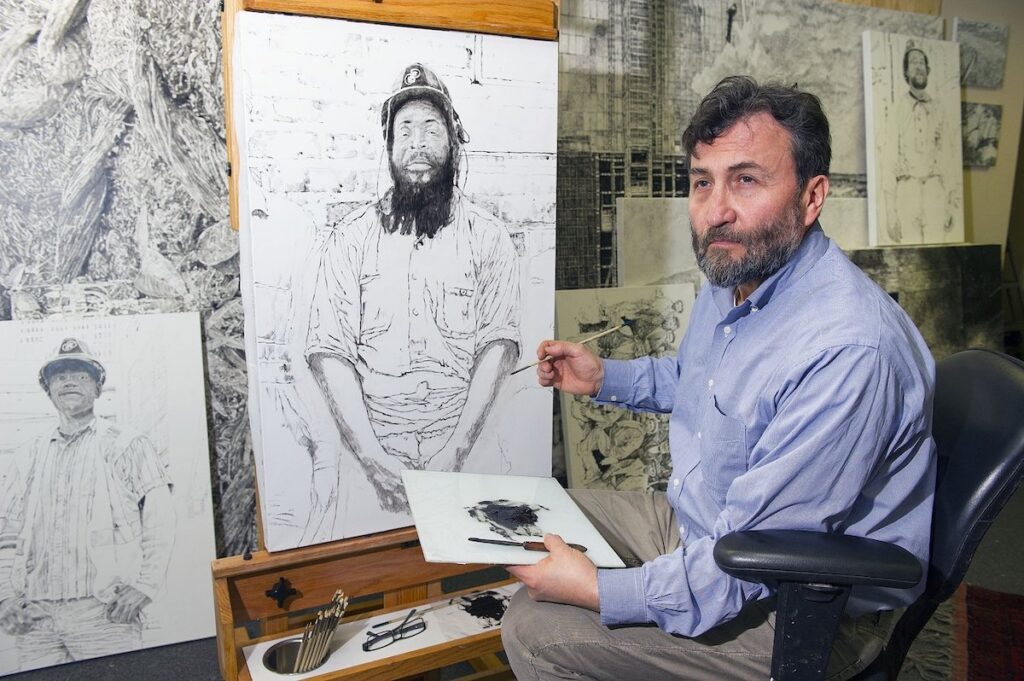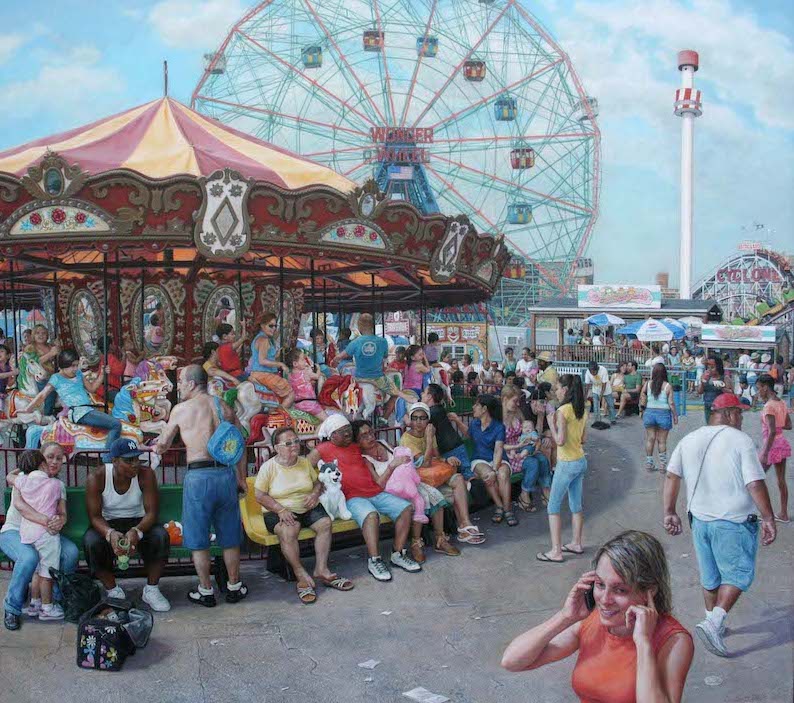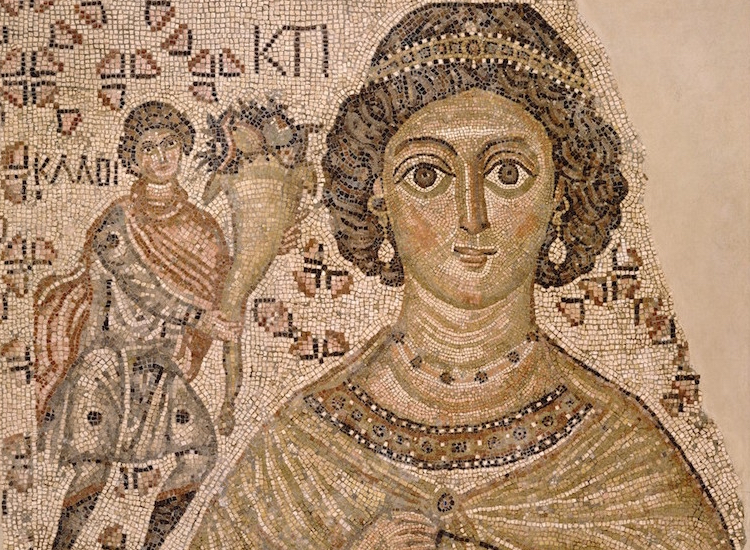
At what age did you decide to become an artist?
I was four years old when I started using a pencil well. I would watch my dad practice his mail-order drawing lessons and, not knowing how difficult rendering was, I kept at it with a motive: the more real I could render the subject, the more real it was for me. Thus, being from a family of recent poor immigrants from Ecuador, I began to have an extensive collection of big rigs and prehistoric animals. I didn’t quite understand the power of how the image is able to communicate without words so effectively. But I did know that I could capture form and turn it into meaning. I officially decided to become an artist freshmen year in college when I changed majors from psychology to art. I would look back several times at that deciding moment in a cold sweat.
How did your parents react when you told them you wanted to be an artist?
My father was a sculptor in Ecuador. However, for political and economical reasons, he left Quito with my mom to settle and begin a new life in New York City. His life as a young man was pretty much defined by his own choices. My great grandparents were both financially well-to-do and politically powerful. To lose all this in a manner of a single generation was humbling for my dad. Fast-forward, my parents did see this ability I had magically acquired as special, however, from their perspective, I needed to support it, and not by starving while doing it. They had mentioned a few times approaching architecture as a vocation, which would allow me to be expressive and self-supporting. I was not that kind of creative. I realized I had something to say about what was happening around me, and I was not so interested in designing forms under someone’s expectations. My first black-and-white work of substance was executed during my senior year in high school. Ducks in Herd (1974) is an image depicting a Vietnamese family tending to their daily chores near their grass hut. The work depicts the serene life in the countryside with people going about their simple chores, whom we didn’t know nor yet understand why we were waging a war against them. After I completed that work, I think my parents never brought up the topic of another profession again. Subconsciously, they did influence my major when I entered Rutgers on a full scholarship, but that would change, despite acing all my psych classes. If I was going to work that hard to be a psychiatrist, I could direct my all my attention to being an artist come what may.
Who are your favorite artists?
Rauschenberg, Cézanne, Richter, Picasso, Man Ray, Keifer, Baldessari, Corot, Velázquez, Manet, Delacroix, Brian Dewan, Bill Viola, van Gogh, Sorolla y Bastida, Sargent, Bonnard, Hopper, Kubrick, Arbus, Scorsese, Oppenheimer, William Bailey, Ed Rausch…
Who is your favorite artist whose work is unlike your own?
Bill Viola. His videos are paintings but are set up/staged in slow-motion video format. His works show what was, what has happened since that point, and a result. My work is a still image. There is a great deal to the still, however, for instance, to see how those souls on the The Raft of the Medusa got there, what happened to the ship, and what will become of them is left to our imagination, and that is good. But Viola’s work gives one more information that can lead to more discourse.
Art book you cannot live without?
The Art of War. I think and breathe as an artist for most of my time. I find it necessary to fill my mind with notions, ideas that can challenge how I see; it becomes an aid to how to interpret life around me and make view points that are skewed, off center, and anew in order to deconstruct and reconstruct.
What is the quality you most admire in an artist?
The ability to renew our senses, our perception of the ordinary, the mundane and the standard in ways that excite and inform the world around us.
Do you keep a sketchbook?
Yes, I carry a sketchbook to make thumbnails, write, and attach visuals I find in my daily travels. I also use my smart phone to record anything of interest, which later will be used as visual references or classified as artwork.
What’s your favorite museum in all the world?
The Prado. A week to see it all and a lifetime to uncover all its secrets, and with the Met and Louvre right behind a close second.
What’s the best exhibition you have ever attended?
The first Rauschenberg retrospective at MoMA in the late 70s is the best show I have ever attended for good reason. I saw the creative spirit of unbound expression. Bob was a conduit of potent images of our life experience which he would place hold for us in his works. In one room, as I had made my way around each work I came across one extremely minimal piece, a clear sheet of Plexiglas with a cracked corner, finger prints all over it held in place with four brass slot head screws holding it fixed to the white gallery wall. I could see the reflections of the people behind me on the Plexiglas. I thought how simple yet potent, there was reflection, index and content of the fleeing moment. The wall it was attached to began to move….. it actually was a door that the Plexiglas was attached to and it was not an artwork but a door guard to protect the painted hidden door. What the show was able to do was to open my eyes to the possibility of what art can be, if it contents certain qualities it could be used as art.
If you were not an artist, what would you be?
Social activist. My artwork for the past thirty years has addressed social and economic issues.
How did your early artistic cohort influence your development?
Rauschenberg taught me juxtaposition; Cézanne, color form reduction; Richter, suspension of the fleeting moment; Picasso, innovation and mastery; Man Ray, how the subconscious is conscious somehow all the time. Every artist I listed above (and others) has had an impact on me that together help define my application and philosophy.
What is one thing you didn’t learn in art school that you wish you had?
That art is made of four components: It reflects. It is of this moment. In order to move forward, one needs to look back in history. Art should offer a new consideration (novelty, the extraordinary, a new and interesting approach). Art has been mistaken as the sole ability to render, execute, or simply create, and this is not art, but technical ability.
What work of art have you looked at most and why?
I have two important artworks I visit: the Velázquez’s portrait of Juan de Pareja and van Gogh’s Irises. Velázquez captured the self-assured, proud, and noble character of a man who could be counted upon regardless of the situation. Portraits by Velazquez’s contemporaries are more like light studies, stiff and posed, but this one touches on qualities of the human spirit that words fail to communicate. Van Gogh’s Irises are the finest example of how humanity can translate an already appreciated /understood person, place, or thing in a deeper manner. Since, I can’t help but see irises as ordinary, they don’t compare to his. That goal, that place both works bring me, is where I set my sight every moment I sit in front of the easel/table/wall. I keep moving towards that in the hopes of reaching it.
What is your secret visual pleasure outside of art?
The human form and the light from the blue stained glass coming through the windows of Notre Dame.
Do you listen to music in your studio?
Yes, I listen to classical music so as not to take me away too far from my concentration. I noticed that music with lyrics would drive my imagination and that was disruptive. While I am working, my practice is quite like meditation: being present in the endeavor, having complete attention focused on the brush/pencil/whatever movement with the form is pleasure, is calm, and music, which is purely abstract like classical arrangements, allows me to easily remain in that state.
What is the last gallery you visited?
I don’t remember. I was traveling with a small group and we were on a gallery crawl in early March. We visited a number of galleries; one of them was the Zwirner. They were showing a notable landscape painter.
Who is an underrated artist people should be looking at?
Brian Dewan and his short films. Melanie Vote and her paintings on alienation and the sublime. David Strar’s stream of consciousness drawings and narratives. Joe Peña and his paintings of street food carts. There are many more …
What art materials can you not live without?
Black and sepia oil paint, stand oil, 1 and 2 size hog hair and sable brushes, stretched and sized smooth linen, Arches cover cold press paper, Internet access for courses on my Mac laptop, an Epson projector, kneaded eraser, conté crayons, literature/readings on aesthetics and critical works.
Do you paint/sculpt/create art every day?
Yes, I’ll put down a mark for a moment or for hours, I’ll capture daily occurrences on my smart phone, write about a moment. It is a part of being for me.
What is the longest time you went without creating art?
Two months… I was miserable.
What do you do when you are feeling uninspired?
I will normally read the news, interact with others about certain topics, or engage with them on their concerns, participate in cultural events of any type. View movies and think of their representation and translate that into painting. I feel there is an enormous amount of material that can trigger an inspiration provided that we are engaged with the world around us. Reading is helpful just the same. I feel as long as we are breathing we should always have a topic that drives us to translate into art.
What are the questions that drive your work?
Does this seem right, is it fair, is it misleading, is it of consequence, is it overlooked, misunderstood, underestimated, of vital importance? My work is normally composed after an idea is thought about. How can I express this with careful observation, juxtaposition, analogy, metaphor and from a different vantage point than the obvious? How can I reflect this extraordinary time/moment in our life effectively?
What is the most important quality in an artist?
A sense of duty to communicate those aspects of our existence that are difficult to speak about, hear about, taste, and smell. There is genuineness when an artist is comfortable with themselves, honest with themselves, and engaged in our profession. I find that those are the most generous, kind, and delightful. The posers are the opposite: insecure, attention-grabbing, suspicious, and viper-like. We may all have had moments of the latter, but they are passing moments that don’t define us.
What is something you haven’t yet achieved in art?
I feel recognition from the “pillar” art establishment (those places with, or without, pillars flanking their entrances, e.g. the Met.). I feel that the establishment is a close-knit community that talks within its circles and rarely ventures from it. With that, I am left to continue with or without their support.
What is the best thing about art in the era of social media?
That artwork can reach many, which hopefully will engage viewers to visit in person those artworks, museums, galleries, etc… I also feel with this current world crisis that social media has opened new venues to seize some power in our potency as creators rather than wait for the establishment to shed light on us. I hope that new opportunities will come to the front lines from this event.
Hugo Bastidas teaches “Art Theory & Criticism” at the Art Students League.




